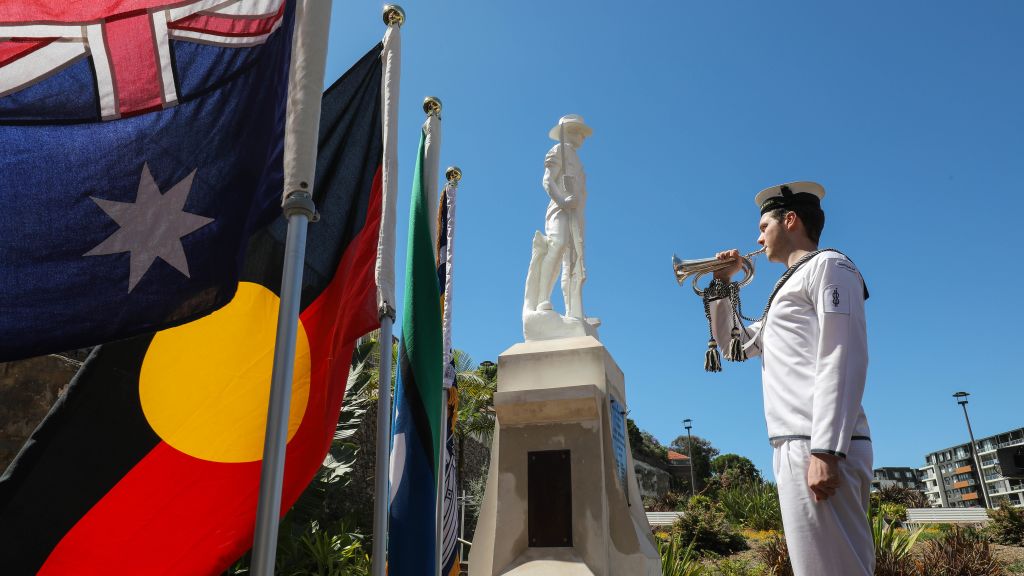The first statue of a World War I soldier carved in Australia has returned to its original home in time for the centenary of the guns falling silent on the Western Front.
City of Sydney Lord Mayor Clover Moore today led a formal ceremony to rededicate the historic memorial that was first unveiled at the Rozelle tram depot on 26 November 1916.
The Glebe Society, the RSL and State Transit were among those who campaigned for the historic memorial's restoration, which was overseen by the City of Sydney. They joined the event at the new memorial site where local church members performed a rededication ceremony, the Lord Mayor laid a wreath and a bugler played the Last Post.

The war memorial digger statue was the first in Australia commissioned and paid for by donations from the work comrades of soldiers who died during the First World War.
Devastated by the deaths of their colleagues at Gallipoli and later on the Western Front, the Rozelle tram workers banded together to fund the statue, which was housed in the workers' award-winning gardens.
For 40 years, the digger stood guard outside the Rozelle tramsheds. When they were closed in 1958, it was moved with the tram workers to the Leichhardt bus depot. Specialist restoration experts, International Conservation Services, were brought in to repair the historic figure.
"This memorial was created at a time when people - dismayed by the horrors of trench warfare - confidently believed, or hoped, that it was the war to end all wars," the Lord Mayor said.
"Unfortunately, as we know, the 20th century was punctuated by some of the most horrific conflicts in human history.
"This great memorial has come home, restored to its rightful place to help remind us that war has caused the death of too many young Australians.
"The men memorialised here dreamed of something better and were prepared to fight for their beliefs. This memorial makes their sacrifice real, despite the years between them and us.
"It's fitting that we rededicate this memorial today, only three days before Australia and the world commemorate the 100th anniversary of the official end of World War I - at 11am on 11 November 1918."
In all, 120 tram depot workers volunteered to fight in World War I. Of these, 34 men lost their lives and their names are listed on the memorial's copper plaques. Four died in Gallipoli, the remainder on the Western Front.
Of the four who served at Gallipoli, the youngest worker, Selby Stewart, was 20 years old and perished during the landing at Anzac Cove on 25 April 1915.
The last man to die was one of the eldest, 36-year-old Peter Collins, a tram conductor who died in France on 30 September 1918.
Michael Reardon, State Transit executive director asset management, started with the authority in 1980 as a 15-year-old apprentice motor mechanic and manages more than 250 staff and thousands of assets, including the statue.
"Digger, or as we refer to him 'the soldier', will always hold a special place in the history of State Transit, but I'm glad we could work with the City of Sydney and the RSL to relocate him back to his original Rozelle home so the wider community can get to know him, " Mr Reardon said.
The statue was crafted from cement and created in Sydney by Irish-born sculptor, Edwin W. McGowan, in 1916. Mr McGowan, who lived in Leichhardt for several years, became known for his work creating lifelike digger statues.
Unusually for its time, the statue depicts an Australian soldier in a relaxed pose, his slouch hat turned down all round, an open collar and rolled up sleeves, holding a rifle with the bayonet fixed and ready for battle.
McGowan's work pre-dated the formal requirements of the Public Monuments Advisory Board, and he created a sculpture that is clearly dedicated to the everyday soldier. It is very different from the hundreds of later works that feature a formally posed soldier or officer in full uniform and a position of reflection.
The statue was in poor condition, with rust marks, cracks and peeling paint when it was taken from the Leichhardt bus depot for restoration.
Ted McKeown from the Glebe Society served in the Australian Army Reserve for 12 years and was among those who spearheaded the local association's advocacy for the return of the memorial to Harold Park.
"It's entirely appropriate that this memorial should be rededicated within a few days of the centenary of the Armistice, reminding visitors that Glebe has not forgotten these brave men," Mr McKeown said.
"The statue will stand as a lasting symbol of their sacrifice and, given its prominent position, will remind visitors for many years of the heroism and bravery of the workers of the tramsheds.
"Today's rededication ceremony restores and honours an important milestone in the history and heritage of the Glebe community."
For media inquiries or images, contact Belinda Wallis.
Phone 0467 810 160 or email bwallis@cityofsydney.nsw.gov.au
For interviews with Lord Mayor Clover Moore, contact Julia Lenton.
Phone 0410 748 039 or email jlenton@cityofsydney.nsw.gov.au
